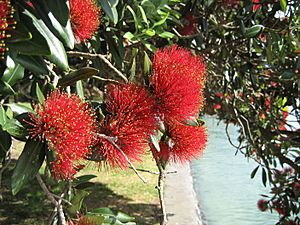Metrosideros facts for kids
Quick facts for kids Metrosideros |
|
|---|---|
 |
|
| Flowers and leaves of M. excelsa | |
| Scientific classification |
|
| Kingdom: | Plantae |
| Clade: | Tracheophytes |
| Clade: | Angiosperms |
| Clade: | Eudicots |
| Clade: | Rosids |
| Order: | Myrtales |
| Family: | Myrtaceae |
| Subfamily: | Myrtoideae |
| Tribe: | Metrosidereae |
| Genus: | Metrosideros Banks ex Gaertn. |
| Species | |
|
See text |
|
| Synonyms | |
|
|
Metrosideros is a group of about 60 different kinds of trees, shrubs, and vines. They mostly grow in the Pacific Ocean region. These plants belong to the Myrtaceae family, which also includes plants like eucalyptus.
Most Metrosideros trees are small. However, some, especially those from New Zealand, can grow very large. The name Metrosideros comes from two Ancient Greek words: metra, meaning "heartwood" (the hard inner part of a tree trunk), and sideron, meaning "iron". This name likely refers to how strong their wood is.
Some of the most famous Metrosideros plants are the pōhutukawa (M. excelsa), northern rātā (M. robusta), and southern rātā (M. umbellata) from New Zealand. Another well-known one is the ʻōhiʻa lehua (M. polymorpha), which grows in the Hawaiian Islands.
Contents
Where do Metrosideros plants grow?
Metrosideros is one of the most widespread groups of flowering plants in the Pacific Ocean. Many different species are found across various islands.
For example, New Caledonia has 21 types of Metrosideros. New Zealand has 12 types, New Guinea has seven, and Hawaii has five. You can also find these plants on most other large Pacific Islands. These include the Solomon Islands, Vanuatu, Fiji, Samoa, Cook Islands, French Polynesia, Bonin Islands, and Lord Howe Island. However, they are not found in Micronesia.
The genus also has one species in the Philippines, one in South America (Chile and Argentina), and one in South Africa.
How do Metrosideros spread so far?
Metrosideros seeds are very light, so the wind can easily carry them long distances. These seeds can also survive freezing temperatures. They can even stay underwater in saltwater for up to 30 days and still sprout! This ability to survive harsh conditions helps explain why they are found in so many different places.
You often find Metrosideros plants growing as some of the first trees on new lava flows or along mountain ridges. This shows how tough and adaptable they are. Interestingly, even with their ability to spread far, this group of plants does not grow naturally in mainland Australia today.
How do we know about ancient Metrosideros?
For a while, scientists thought that Metrosideros plants first appeared in New Zealand. They believed the plants then spread from there across the Pacific. This idea came from finding many old Metrosideros fossils in New Zealand. Also, no fossils of these plants had been found on other ancient landmasses from Gondwana.
The oldest clear fossil evidence of Metrosideros in New Zealand is fossil fruits. These fruits were found in rocks from the Miocene period in Central Otago. There are even older fossil pollen records. However, Metrosideros pollen looks very similar to pollen from many other plants in the Myrtaceae family. Because of this, fossil pollen alone cannot reliably tell us the oldest record of the genus.
The oldest definite record of Metrosideros comes from fossil fruits and flowers of an extinct species called Metrosideros leunigii. These fossils were found in rocks from the Oligocene period in Tasmania, Australia. This is very interesting because Metrosideros is not found in Australia today. These fossils might suggest that the genus actually started in Australia.
Growing Metrosideros plants
People often grow Metrosideros plants because their flowers are very beautiful. They are planted along streets or in home gardens. The flowers are usually red, but some types have orange, yellow, or white flowers.
Some names you might see in plant catalogs, like M. villosa and M. vitiensis, are actually just different types or cultivated versions of M. collina, not separate species.
The pōhutukawa from New Zealand is grown in Australia, Hawaii, and California. It has also been successfully planted in northern Spain and on the Scilly Isles off the coast of Britain. However, this species is considered a problem plant in parts of South Africa and in the Azores because it spreads too much.
Metrosideros kermadecensis has recently started growing wild in Hawaii. It also has the potential to become a problem plant there. In New Zealand, many different types of M. collina and M. polymorpha are widely grown.
Metrosideros umbellata naturally grows south of mainland New Zealand in the Auckland Islands, which are very far south. This makes it the toughest member of the genus. A few cultivated plants of this species are even growing in Scotland.
Types of Metrosideros plants
South America
South Africa
|
New Guinea
Philippines
|
French Polynesia, Pitcairn and the Cook Islands
Fiji, Samoa and Vanuatu
Solomon Islands
Lord Howe Island
Ogasawara Islands
|
Images for kids
-
A young pohutukawa (Metrosideros excelsa) in flower at Ōhope, near Whakatāne, New Zealand. Whale Island in background.
See also
 In Spanish: Metrosideros para niños
In Spanish: Metrosideros para niños


